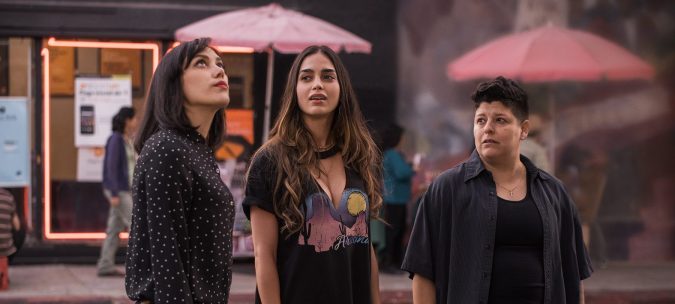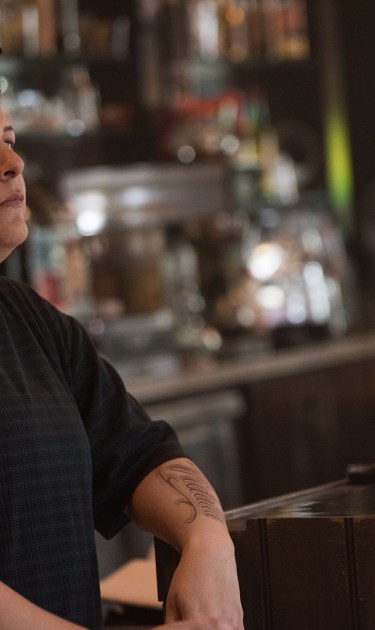Ser Anzoategui was used to hearing no. “Ay no es posible!” they heard at home from family. “No,” they heard at casting calls and auditions. “No,” the world seemed to be telling them. Living in Los Angeles, which greets all those who arrive with the promise that, “Yes, you can make your dreams come true here” made it even harder. Anzoategui always felt like the realities of their gender identity and their racial identity (they describe themself as a non-binary Latinx/Chicanx actor/playwright/artivist) made hearing those “No’s” all the more debilitating. But rather than wallow in negativity, they persevered. After penning solo shows about their life, nabbing a role on Hulu’s East Los High, and working alongside the East Side community where they grew up, Anzoategui is ready to take on the role of their career as Eddy in Starz’s upcoming series, Vida.
Set in the very neighborhood where Anzoategui grew up, Tanya Saracho’s queer Latinx series is an ode to East LA. The show follows two sisters, Lyn and Emma (Melissa Barrera and Mishel Prada) who reconnect after their mother dies. But as they grieve they must come to terms with the life their mother was living in her last few years. Namely, she was living with and had been married to Eddy, whom Anzoategui lovingly dubs “a queer lesbiana from the East Side.” Moreover, they learn their mother left the building that housed her apartment and bar to the three of them, further straining the already tense relationships between the sisters and their mother’s widow.
For Anzoategui, the role of Eddy is decades-in-the-making. Here is a butch lesbian who rocks a great fade and a white tank top, yet whose tenderness towards her late partner make her a standout in her community. You may think you know her when she shows up on screen, but as with every character in Vida, the show is intent on pulling back their layers and revealing each as a fully fleshed-out character. It helps that Anzoategui had such a history with the changing neighborhood that Saracho’s show is tracking. Originally from Huntington Park, CA, they grew up in various East Los Angeles and San Gabriel Valley communities, often finding themself fighting for the very things that Vida dramatizes: Emma, ever the pragmatist, is intent on selling her mother’s building despite knowing she’ll likely be helping the gentrification at work in the area and perhaps even putting Eddy out of a home.

For a performer and writer who has long seen activism and art-making as two sides of the same coin, Vida offered the chance to finally be a part of the stories Anzoategui has long been wanting to tell on a high-profile platform. Television, after all, was where Anzoategui first connected with the world outside their home. “I found myself watching television to just feel something,” they remember. And it was there that Anzoategui found the inspiration they needed: a John Leguizamo special on HBO.
“That’s when I really felt that I saw something that connected to me. I didn’t go to the theater but I knew that that’s what I wanted to do at that point.” Turning to the theater became a survival tool, a way to find solace from a world, at home and school, that didn’t understand them. “I really just fell in love with the theater because it was a refuge from violence, from not connecting with my immigrant parents.” It was in the theater that Anzoategui found the community they so desperately needed. Where Anzoategui’s parents still felt a connection to their home countries in Latin America (Argentina and Paraguay, where they eventually returned), Anzoategui felt a kinship to the local community in the East Side of Los Angeles. And it’s that tight-knit community that took care of Anzoategui and took them in when they were homeless and in most need of support.
As Anzoategui found out, Hollywood struggles with widening its myopic view of what a successful actor can look like. “I was auditioning but I would have a hard time booking opportunities,” they explain. Even though Anzoategui was femme-presenting at the time, it became clear that directors were unsure about how to cast them. “I wasn’t femme enough,” they posit, an issue that became even more pronounced in the theater where casting notices were usually much more firmly drawn along gender lines. When they then started writing their own shows, Ser and Catholic Schools Daze, both of which bristled with frank autobiographical anecdotes, Anzoategui got to see another way in which their identity at times felt like a barrier. Critics (often white older men) were quick to inform them that there was “too much” in those stories they were telling. It always felt like hearing those “No’s” from their family yet again; Anzoategui was too much and yet not enough.
The road may not have been easy but Anzoategui is more than proud to have Vida be the project that finally gave them the kind of role they’d use to have to write for themselves. Here is a show that’s unafraid to tackle gentrification in LA, colorism within the Latinx community, and queer intersectional identities with equal candor. For Anzoategui, this is a show that feels designed to tell others to say yes to themselves. As they told Remezcla, “I think I kept saying yes to my own intuition and it allowed me to tell my story.” But it’s even more rewarding to be part of something that’s giving voice to the varied communities they belong to. “Watching and being reflected on the screen so many different identities within the queer and Latinx community in the East Side is so special and so necessary.” It’s also, as they add, about time.




